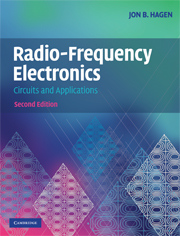Book contents
- Frontmatter
- Contents
- Preface
- 1 Introduction
- 2 Impedance matching
- 3 Linear power amplifiers
- 4 Basic filters
- 5 Frequency converters
- 6 Amplitude and frequency modulation
- 7 Radio receivers
- 8 Suppressed-carrier AM and quadrature AM (QAM)
- 9 Class-C, D, and E Power RF amplifiers
- 10 Transmission lines
- 11 Oscillators
- 12 Phase lock loops and synthesizers
- 13 Coupled-resonator bandpass filters
- 14 Transformers and baluns
- 15 Hybrid couplers
- 16 Waveguide circuits
- 17 Small-signal RF amplifiers
- 18 Demodulators and detectors
- 19 Television systems
- 20 Antennas and radio wave propagation
- 21 Radar
- 22 Digital modulation techniques
- 23 Modulation, noise, and information
- 24 Amplifier and oscillator noise analysis
- 25 The GPS Navigation system
- 26 Radio and radar astronomy
- 27 Radio spectrometry
- 28 S-parameter circuit analysis
- 29 Power supplies
- 30 RF test equipment
- Index
- References
30 - RF test equipment
Published online by Cambridge University Press: 05 June 2012
- Frontmatter
- Contents
- Preface
- 1 Introduction
- 2 Impedance matching
- 3 Linear power amplifiers
- 4 Basic filters
- 5 Frequency converters
- 6 Amplitude and frequency modulation
- 7 Radio receivers
- 8 Suppressed-carrier AM and quadrature AM (QAM)
- 9 Class-C, D, and E Power RF amplifiers
- 10 Transmission lines
- 11 Oscillators
- 12 Phase lock loops and synthesizers
- 13 Coupled-resonator bandpass filters
- 14 Transformers and baluns
- 15 Hybrid couplers
- 16 Waveguide circuits
- 17 Small-signal RF amplifiers
- 18 Demodulators and detectors
- 19 Television systems
- 20 Antennas and radio wave propagation
- 21 Radar
- 22 Digital modulation techniques
- 23 Modulation, noise, and information
- 24 Amplifier and oscillator noise analysis
- 25 The GPS Navigation system
- 26 Radio and radar astronomy
- 27 Radio spectrometry
- 28 S-parameter circuit analysis
- 29 Power supplies
- 30 RF test equipment
- Index
- References
Summary
In RF work, as in low-frequency work, test instruments generally are designed either to analyze signals, or to determine parameters of components and systems. Signal analysis ranges from simple voltage, current, and power measurements to measurements of frequency, relative phase, frequency stability, modulation characteristics, RF field strength, and spectrum analysis. Parameter measurements range from simple resistance and reactance measurements through measurements of transfer characteristics of linear multiport devices (filter shapes, amplifier frequency response, etc.), and distortion (dynamic range, intermodulation). Parameter measurements require a signal generator to provide the stimulus whose response is measured. It is now common for measurement instruments to include built-in signal generators, but free-standing signal generators are widely used in specialized test setups.
Power measurements
Power measurements, as pointed out in Chapter 18, are best made with a square-law detector. If the waveform is unknown or noisy (i.e., has a random component), a square-law detector must be used, as power, by definition, is proportional to the average square of voltage. If the signal waveform is known, e.g., a sine wave, the power can also be calculated, for example, from a measurement of 〈|V(t)|〉. Commercial RF power meters normally present a 50-ohm impedance to source being measured, allowing a reflectionless connection to a 50-ohm cable.
Thermistor (temperature-dependent resistor) power meters are true square-law instruments and have a dynamic range typically from 1 μW (−30 dBm) to 100 mW (20 dBm). The power to be measured heats a thermistor which is one leg of a Wheatstone bridge circuit.
- Type
- Chapter
- Information
- Radio-Frequency ElectronicsCircuits and Applications, pp. 422 - 433Publisher: Cambridge University PressPrint publication year: 2009



